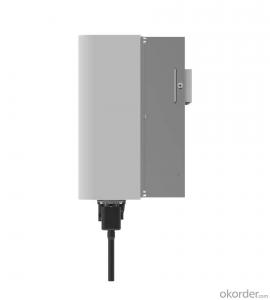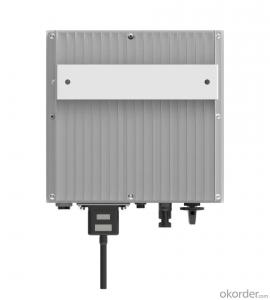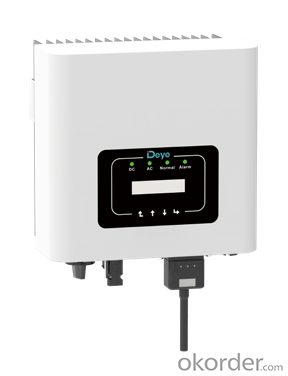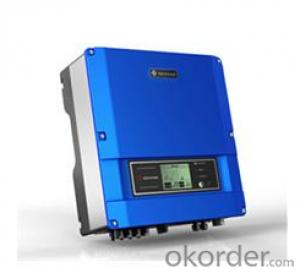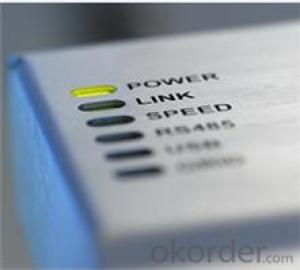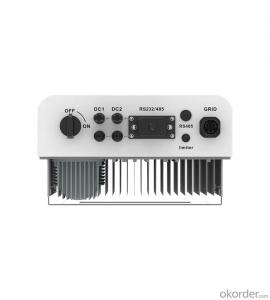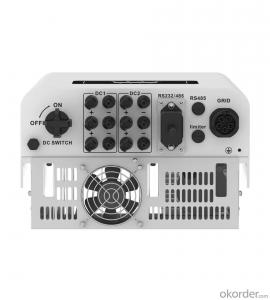Solar Inverter Dealer - sun-1/1.5/2/2.5/3k-g | 1.5-3kw | Single Phase | 1 MPPT
- Loading Port:
- Ningbo
- Payment Terms:
- TT OR LC
- Min Order Qty:
- 100 pc
- Supply Capability:
- 5000 pc/month
OKorder Service Pledge
OKorder Financial Service
You Might Also Like
Specification
The innovative design of the SUN-1/1.5/2/2.5/3K-G is not only easy to install, but also allows for quick DC and AC connections. E.g. it weighs just 6 kg. Commissioning is equally easy, because the integrated user interface (local LCD display and buttons) makes it possible to choose the necessary settings quickly.
· 1 MPP tracker, Max. efficiency up to 97.5%
· Zero export application,VSG application
· String intelligent monitoring (optional)
· Wide output voltage range
· Anti-PID function(Optional)
| Technical Data | ||||||
| Model | SUN-1K-G | SUN-1.5K-G | SUN-2K-G | SUN-2.5K-G | SUN-3K-G | |
| Input Side | ||||||
| Max. DC Input Power (kW) | 1.3 | 2 | 2.6 | 3.3 | 3.9 | |
| Max. DC Input Voltage (V) | 550 | |||||
| Start-up DC Input Voltage (V) | 80 | |||||
| MPPT Operating Range (V) | 70~500 | |||||
| Max. DC Input Current (A) | 13 | |||||
| Max. Short Circuit Current (A) | 19.5 | |||||
| Number of MPPT / Strings per MPPT | 1/1 | |||||
| Output Side | ||||||
| Rated Output Power (kW) | 1 | 1.5 | 2 | 2.5 | 3 | |
| Max. Active Power (kW) | 1.1 | 1.7 | 2.2 | 2.75 | 3.3 | |
| Nominal Output Voltage / Range (V) | L/N/PE 220V/0.85Un-1.1Un, 230V/0.85Un-1.1Un (Optional) | |||||
| Rated Grid Frequency (Hz) | 50 / 60 (Optional) | |||||
| Operating Phase | Single phase | |||||
| Rated AC Grid Output Current (A) | 4.3 | 6.5 | 8.7 | 10.9 | 13 | |
| Max. AC Output Current (A) | 4.8 | 7.2 | 9.6 | 12 | 14.3 | |
| Output Power Factor | 0.8 leading to 0.8 lagging | |||||
| Grid Current THD | <3%< td=""> | |||||
| DC Injection Current (mA) | <0.5%< td=""> | |||||
| Grid Frequency Range | 47~52 or 57~62 (Optional) | |||||
| Efficiency | ||||||
| Max. Efficiency | 97.3% | 97.3% | 97.3% | 97.3% | 97.5% | |
| Euro Efficiency | 97.1% | 97.1% | 97.1% | 97.1% | 97.3% | |
| MPPT Efficiency | >99% | |||||
| Protection | ||||||
| DC Reverse-Polarity Protection | Yes | |||||
| AC Short Circuit Protection | Yes | |||||
| AC Output Overcurrent Protection | Yes | |||||
| Output Overvoltage Protection | Yes | |||||
| Insulation Resistance Protection | Yes | |||||
| Ground Fault Monitoring | Yes | |||||
| Anti-islanding Protection | Yes | |||||
| Temperature Protection | Yes | |||||
| Integrated DC Switch | Yes | |||||
| Remote software upload | Yes | |||||
| Remote change of operating parameters | Yes | |||||
| Surge protection | DC Type II / AC Type II | |||||
| General Data | ||||||
| Size (mm) | 280W×272.5H×184D | |||||
| Weight (kg) | 4.8 | |||||
| Topology | Transformerless | |||||
| Internal Consumption | <1W (Night) | |||||
| Running Temperature | -25~65℃, >45℃ derating | |||||
| Ingress Protection | IP65 | |||||
| Noise Emission (Typical) | <25 dB | |||||
| Cooling Concept | Natural cooling | |||||
| Max. Operating Altitude Without Derating | 2000m | |||||
| Warranty | 5 years | |||||
| Grid Connection Standard | CEI 0-21, VDE-AR-N 4105, NRS 097, IEC 62116, IEC 61727, G99, G98, VDE 0126-1-1, RD 1699, C10-11 | |||||
| Operating Surroundings Humidity | 0-100% | |||||
| Safety EMC / Standard | IEC/EN 61000-6-1/2/3/4, IEC/EN 62109-1, IEC/EN 62109-2 | |||||
| Features | ||||||
| DC Connection | MC-4 mateable | |||||
| IP65 rated plug | ||||||
| Display | LCD1602 | |||||
| Interface | RS485/RS232/Wifi/LAN | |||||
- Q: Can a solar inverter be used with a generator?
- Yes, a solar inverter can be used with a generator. In fact, it can be a useful combination in situations where solar power is not sufficient or unavailable. The generator can provide backup power to charge the batteries or directly power the inverter, which then converts the DC power from the generator into AC power for use in electrical appliances and systems.
- Q: How does a solar inverter handle voltage phase imbalance in the grid?
- A solar inverter handles voltage phase imbalance in the grid by monitoring the phase angles of the grid voltage and adjusting its output accordingly. It continuously measures the phase imbalance and corrects it by injecting reactive power into the grid. This helps to balance the voltage across the different phases and maintain stable grid conditions.
- Q: What is the role of a solar inverter in preventing system failures?
- The role of a solar inverter in preventing system failures is to convert the direct current (DC) electricity generated by solar panels into alternating current (AC) electricity that can be used to power homes and businesses. In addition to this conversion, solar inverters also play a crucial role in ensuring the stability and efficiency of the entire solar power system. They monitor and regulate the voltage and frequency of the electricity being generated, protecting the system from overvoltage, undervoltage, and other electrical abnormalities that can potentially lead to system failures. By constantly monitoring and adjusting the electrical output, solar inverters help maintain the health and reliability of the solar power system, ultimately preventing potential failures and maximizing the overall performance.
- Q: What is the maximum operating altitude for a solar inverter?
- The maximum operating altitude for a solar inverter depends on the specific model and manufacturer. However, most solar inverters are designed to operate effectively up to an altitude of around 13,000 feet (4,000 meters) above sea level.
- Q: What is the role of voltage support in a solar inverter?
- The role of voltage support in a solar inverter is to regulate and stabilize the voltage levels within the solar power system. It ensures that the voltage output from the solar panels matches the voltage requirements of the connected devices or the grid. By maintaining a consistent voltage, it helps to prevent overvoltage or undervoltage situations, which could damage the equipment or disrupt the power supply. Voltage support also helps to enhance the overall efficiency and reliability of the solar power system.
- Q: What is the standby power consumption of a solar inverter?
- The standby power consumption of a solar inverter refers to the amount of power it consumes when it is not actively converting solar energy into usable electricity. This power consumption is typically very low, often ranging from a few watts to a few tens of watts, depending on the model and efficiency of the inverter.
- Q: What is the role of ground fault protection in a solar inverter?
- The role of ground fault protection in a solar inverter is to detect and respond to any faults or abnormalities in the electrical system, specifically related to the grounding of the system. It ensures the safety of the inverter, the solar panels, and the overall electrical system by interrupting the flow of current in the event of a ground fault, preventing potential electric shock hazards and damage to the equipment.
- Q: Can a solar inverter be used with solar-powered telecommunications systems?
- Yes, a solar inverter can be used with solar-powered telecommunications systems. A solar inverter is an essential component in converting the direct current (DC) power generated by solar panels into alternating current (AC) power, which is compatible with telecommunications equipment. This enables solar-powered telecommunications systems to operate efficiently and effectively.
- Q: How does a three-phase solar inverter differ from a single-phase inverter?
- A three-phase solar inverter differs from a single-phase inverter in terms of the number of input and output phases it can handle. While a single-phase inverter can only handle a single-phase input and output, a three-phase inverter is designed to handle three-phase input and output. This allows for a more efficient and balanced distribution of power in three-phase electrical systems, making three-phase inverters suitable for larger solar installations or commercial applications.
- Q: Can a solar inverter be used with a solar-powered data center?
- Yes, a solar inverter can be used with a solar-powered data center. A solar inverter is an essential component that converts the direct current (DC) produced by solar panels into alternating current (AC) that can be used to power electrical equipment, including data centers. By integrating a solar inverter into the solar power system of a data center, the generated solar energy can be efficiently used to run the center's operations, reducing reliance on grid electricity and promoting sustainability.
Send your message to us
Solar Inverter Dealer - sun-1/1.5/2/2.5/3k-g | 1.5-3kw | Single Phase | 1 MPPT
- Loading Port:
- Ningbo
- Payment Terms:
- TT OR LC
- Min Order Qty:
- 100 pc
- Supply Capability:
- 5000 pc/month
OKorder Service Pledge
OKorder Financial Service
Similar products
Hot products
Hot Searches
Related keywords

